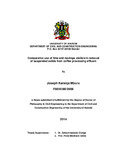| dc.description.abstract | In Kenya,
coffee grows in only a small part of
20% of the whole country
which
is arable land. It grows well between 1200 m and 2100 m above
sea level and an annual rainfall of more than 1000 mm.
Besides that,
coffee does well
in areas
with
red
roam soil wh
ich is
deep and self
-
draining. It is grown by two economic sectors namely the small holder
who are in cooperative societies and in small, medium and large
estates.
It has been identified with
occasional environmental pollution
threat
in
particular during the peak season. Such pollution has been
attributed to the
coffee
p
rocessing wastes in particular the voluminous
effluent
.
However, the final grading effluent which constitutes the
largest component of the
e
ffluent has been recommended fo
r recycling
back to the pulping and washing operations
. The washing effluent is
also preferably mixed with the pulp which can subsequently be
composted for agricultural use.
Therefore,
the pulping effluent remains
as the only component in need of serious c
oncern.
Recent studies
found
minimization
of water used for processing
followed by treatment
as the most practical solution towards a
lleviation
of pollution from
coffee
pulping
effluent
. One of the postulated
forms
of treatment
targets the
removal of the s
usp
ended solids from t
he effluent prior to its
discharge to the percolation
disposal
pits.
The first part of this study sought to relate the levels of suspended
solids in the effluent to the specific amount of water used for
processing the ripe coffee
cherry. That was followed by evaluation of
t
hree options for removing suspended solids from the
pulping effluent
.
The first
trial
degraded
the raw effluent natural
ly
by
allowing it to
remain resident
un
der
normal ambient
laboratory
conditions
until no
more
solids precipitated out of the effluent. During that time the effluent
was not
disturbe
d
except
possibly slightly
during measurements of the
relevant parameters
The second one involved application of
lime
at different rates
to the
effluent immediately af
ter pulping
. The
third
option treated the pulping
effluent with
different rates
of
dry and finely ground oil press cake from
m
oringa
oleifera
seeds.
In all these experiments,
the pH, total and
dissolved solids in
the effluent
were measured at preset
intervals
against time.
The precipitated suspended solids from the effluent were
also measured as well. Other remarkable observations were also made
and recorded.
Finally comparative seepage tr
i
a
ls were conducted using
the raw and treated effluent applied
to the conventional percolation pit
models.
Results of these tr
i
a
ls were such that
natural biodegradation
caused
the removal of solids from an initial concentration of
3
–
9 g/l
to
less
than 2.
0
g/l
in 3
–
10 days
. In general, between 50 to 90% of the soli
ds
were removed from the effluent
within that period
.
However, addition of
lime to the effluent
even at its optimum rate of 2.0 g/l
did not improve
the rate or extent of the solids removal over
the natural settlement. As
for m
oringa
oleifera
,
its optimum application rate was
1.0
–
2.5 g/l
of
effluent.
Th
a
t
dosage
consistently
resulted with a
distinct
precipitation
of solids
from
the effluent
in
24 hours
after treatment.
Since pulping of
coffee is a batch process at almost 24 hour intervals, the
treatment of
effluent with moringa would
therefore
be the most compatible to the
locally practiced
conventional coffee processing system.
As for the disposal of the effluent,
p
ercolation of the treated effluent
from the pits
was
1.66
–
3.75; 3.07
–
6.57 a
nd 1.62
–
2.86
times faster
than
the raw effluent
in
3 sites
located
at Kisii, Koru and Ru
iru
respectively.
Another dimension was that, t
he treated effluent had
mainly
two
phases namely a solids free effluent and settled
sludge.
Occasionally,
either some scum formed on the surface or/and some sludge dislodged
from the bottom to the surface of the effluent. The sludge if from lime xiv
and moringa
treatments has
enhanced potentia
l
for economic
utilization
be
sides broadening the
value addition
options for these
flocculants. | en_US |

